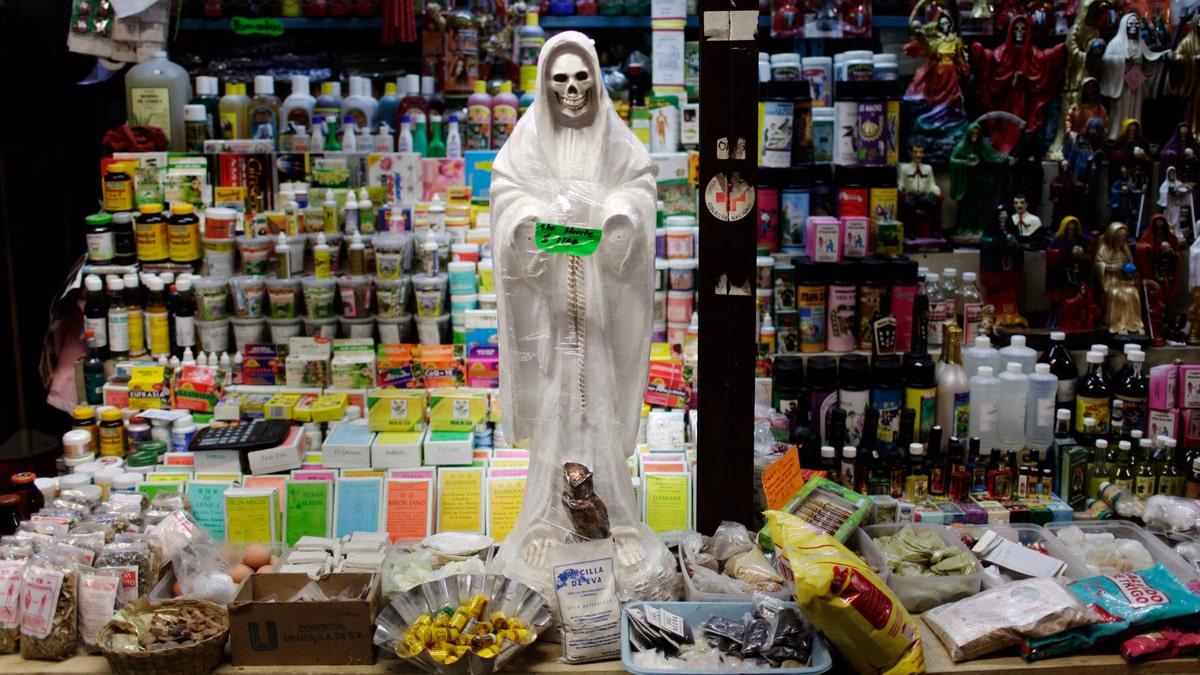
In this April 9, 2009 file photo, a skeletal figure representing the folk saint known in Mexico as "Santa Muerte" or "Death Saint," sits in a vendor's stall at a market in Ciudad Juárez, Mexico. (AP Photo/Rodrigo Abd, File) (AP2009)
NACOZARI, Mexico – Mexican prosecutors are investigating a poor family living near the Mexican border in connection with the ritual killings of three people.
It was a family people took pity on, one the government and church helped with free food, used clothes, and farm animals. The men were known as trash pickers. Some of the women were suspected of prostitution.
Mexican authorities are now investigating whether the any of them are tied to the sacrifices of two 10-year-old boys and a 55-year-old woman to Santa Muerte, or Saint Death, a figure adored mostly by outlaws but whose popularity is growing across Mexico and among Hispanics in the United States.
The killings have shocked the copper mining village of Nacozari, on the edge of the Sierra Madre, and may be the first ritual sacrifices linked to the popular saint condemned by the Roman Catholic Church. Known as "flaquita," or "the skinny one," the figure known as Saint Death is portrayed as a skeleton wearing a hooded robe and holding a scythe, much like the Grim Reaper.
Authorities say the throats and the wrists of the victims were cut with knives and axes, and their blood was spread on a Santa Muerte altar. Their bodies were then buried near the shacks where the alleged cult members lived.
"We never knew they were part of a Santa Muerte cult," said Jorge Sánchez Castillo, a 54-year-old hotel owner who has a corn field next to the house of the woman believed to lead the group. "This has been a tragic thing for all of us."
José Larrinaga, spokesman for the Sonora Attorney General's Office, said 44-year-old Silvia Meraz was the cult leader, and seven people related to her, were detained: her boyfriend Eduardo Sanchez, father, son, three daughters and a daughter-in-law. No formal charges have been filed pending further investigation.
"They thought that by offering the blood, they would be protected for some time," Larrinaga said. "According to them, Santa Muerte was going to tell them where the money was. They all identify themselves as fanatic followers of Santa Muerte."
Nacozari has been spared the grisly violence of drug cartels fighting for lucrative corridors along the U.S.-Mexico border, said police chief José Miguel Espinoza.
"It was a peaceful town. We'd never seen such violence," he said.
When a 10-year-old boy went missing in July 2010, his mother and her boyfriend told police that acquaintances had seen him begging in the streets of nearby Agua Prieta across the border from Douglas, Arizona, and that they would go find him, said Espinoza.
"We had no reason to suspect it was a homicide," he said.
A second 10-year-old boy went missing in early March, prompting Sonora state's missing persons unit to send agents to Nacozari, said the police chief. That boy's mother and her boyfriend reported it to state authorities, who discovered weeks later that the two boys knew people in common.
The missing boy Martin Ríos was the son of the ex-girlfriend of the suspect Eduardo Sánchez. The second boy, Jesús Martínez, was the step-grandson of alleged cult leader Meraz.
Mexico's Drought Hurting Marijuana Farmers
The police chief said both boys would often visit Meraz's home in a poor neighborhood on the outskirts of the town of 11,500.
Espinoza said his officers suspected the house was being used for prostitution after seeing different men from out of town visiting, but never gathered enough evidence to arrest anyone.
Agents on Wednesday unearthed the body of the boy Jesús Martínez buried in the dirt floor in the bedroom of one of the Meraz daughters. They then began arresting the family members, who led them to what agents believe are the remains of the other boy, as well as the grave of 55-year-old Cleotilde Romero, a close friend of Meraz who disappeared in 2009.
Before last week, there have only been unconfirmed reports of human sacrifices related to the figure in Mexico in recent years, said R. Andrew Chesnut, chairman of Catholic studies at Virginia Commonwealth University and author of the book "Devoted to Death: Santa Muerte, the Skeleton Saint."
Chesnut said the 2007 shooting deaths of three men appeared to be related to Santa Muerte because the bodies were abandoned at a shrine to the figure outside the border city of Nuevo Laredo. But they showed no signs of being sacrificial killings.
He said that although most Santa Muerte devotees consider killing a "Satanic aberration of devotion," and that books about the Santa Muerte don't mention human sacrifice, some followers are extreme.
"With no clerical authority to stop them, some practitioners engage in aberrant and even abhorrent rituals," Chesnut said.
Police paraded the eight people arrested in the case of the cult killings into the prosecutor's offices in the state capital of Hermosillo on Friday to allow journalists to view and question them, a typical practice in Mexico.
Meraz told reporters she has believed in Santa Muerte for more than two years.
"Santa Muerte was going to offer us money," Meraz said.
Asked if she thought she had received anything, she answered with a profanity, her voice breaking: "What can she give you? Nothing."
Based on reporting by the Associated Press.
Follow us on twitter.com/foxnewslatino
Like us at facebook.com/foxnewslatino
